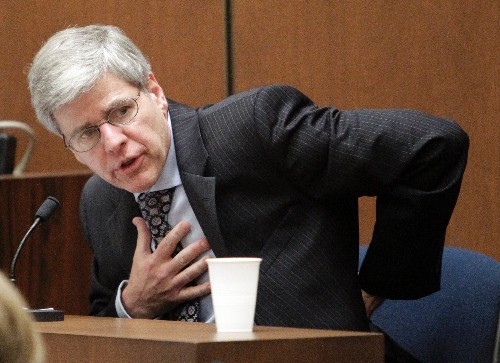Murray caused Jackson’s death, expert testifies
LOS ANGELES -- A medical expert looked jurors in the eyes Wednesday and told them that Michael Jackson's doctor committed 17 flagrant violations of the standard of care for his famous patient and was directly responsible for the death of the King of Pop.
Dr. Steven Shafer at one point called the defendant, Dr. Conrad Murray, "clueless" when it came to using the powerful anesthetic propofol and said Murray didn't know what to do when Jackson stopped breathing.
Prosecutor David Walgren concluded the day's questioning by asking Shafer: "Would it be your opinion that Conrad Murray is directly responsible for the death of Michael Jackson for his egregious violations and abandonment of Michael Jackson?"
Shafer replied, "Absolutely."
Just giving Jackson the anesthetic as a sleep aid was unconscionable, Shafer testified earlier.
"We are in pharmacological never-never land here, something that was done to Michael Jackson and no one else in history to my knowledge," he told jurors.
When Murray found Jackson not breathing, there was nothing more important than calling 911, Shafer said.
Asked about Murray's failure to do so, the witness caught his breath and said, "I almost don't know what to say. That is so completely and utterly inexcusable."
In addition, Murray was acting more like Jackson's employee than a physician who should have rejected the singer's requests for propofol as a sleep aid, Shafer said. "Saying yes is not what doctors do," he testified. "A competent doctor would know you do not do this."
The Columbia University professor and researcher gave jurors a crash course on propofol, an anesthetic used in hospital settings. A video shown to jurors detailed safety measures that were not used by Murray when he administered the drug to Jackson as a sleep aid at the singer's home, according to testimony.
"The worst disasters occur in sedation, and they occur when people cut corners," Shafer said. In Jackson's case, "virtually none of the safeguards were in place," he added.
Shafer said the fact that Murray was on his cellphone in the hours before Jackson's death was a setup for disaster.
"A patient who is about to die does not look all that different from a patient who is OK," he said, adding that doctors cannot multitask and properly monitor a patient who is sedated.
Shafer wrote the package insert that guides doctors in the use of the anesthetic.

















